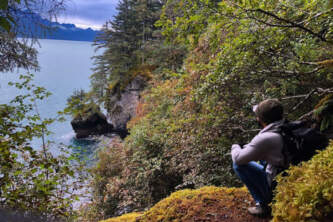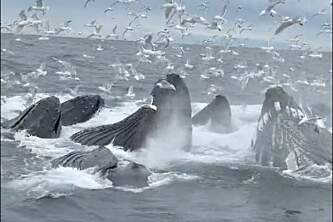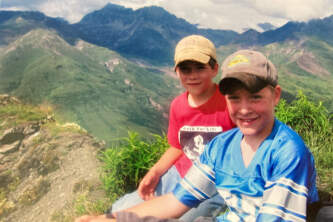A Glacier Moves, and So Do I
By William Jensen
Dawes in neon—ribbed blue face towering above a battlefield of shattered ice.
Dawes Glacier Calving (:21)The first thing I noticed when we turned into Endicott Arm was the air. It wasn’t just cold—it had weight, like every breath was filtered through centuries of ice and stone before reaching me. It carried a sharpness I couldn’t quite place, cleaner than rain, heavier than fog. I leaned over the railing of the small excursion boat, surrounded by about fifty strangers, all of us bundled in puffy jackets and hats that didn’t match, shuffling for position like penguins on a rock. Somewhere behind me, the massive cruise ship I’d stepped off earlier was shrinking into the mist, looking almost delicate against the jagged gray walls of the fjord. This wasn’t brochure Alaska. This was Alaska with its sleeves rolled up.
This wasn’t brochure Alaska. This was Alaska with its sleeves rolled up.
Waterfalls came down the cliffs in long silver braids, some vanishing into the mist halfway, others punching straight into the dark green water with a hiss I could hear over the engines. Ice chunks drifted by us like forgotten sculptures, some the size of footballs, others big enough to make you question the laws of buoyancy. They popped and cracked as they melted, little fizzing sounds like soda bubbles magnified.
Everyone on the boat had their phones out. I did too, but not because I was thinking about posting anything. This was one of those moments where you film not to share, but because your brain refuses to believe your eyes and needs a replay.
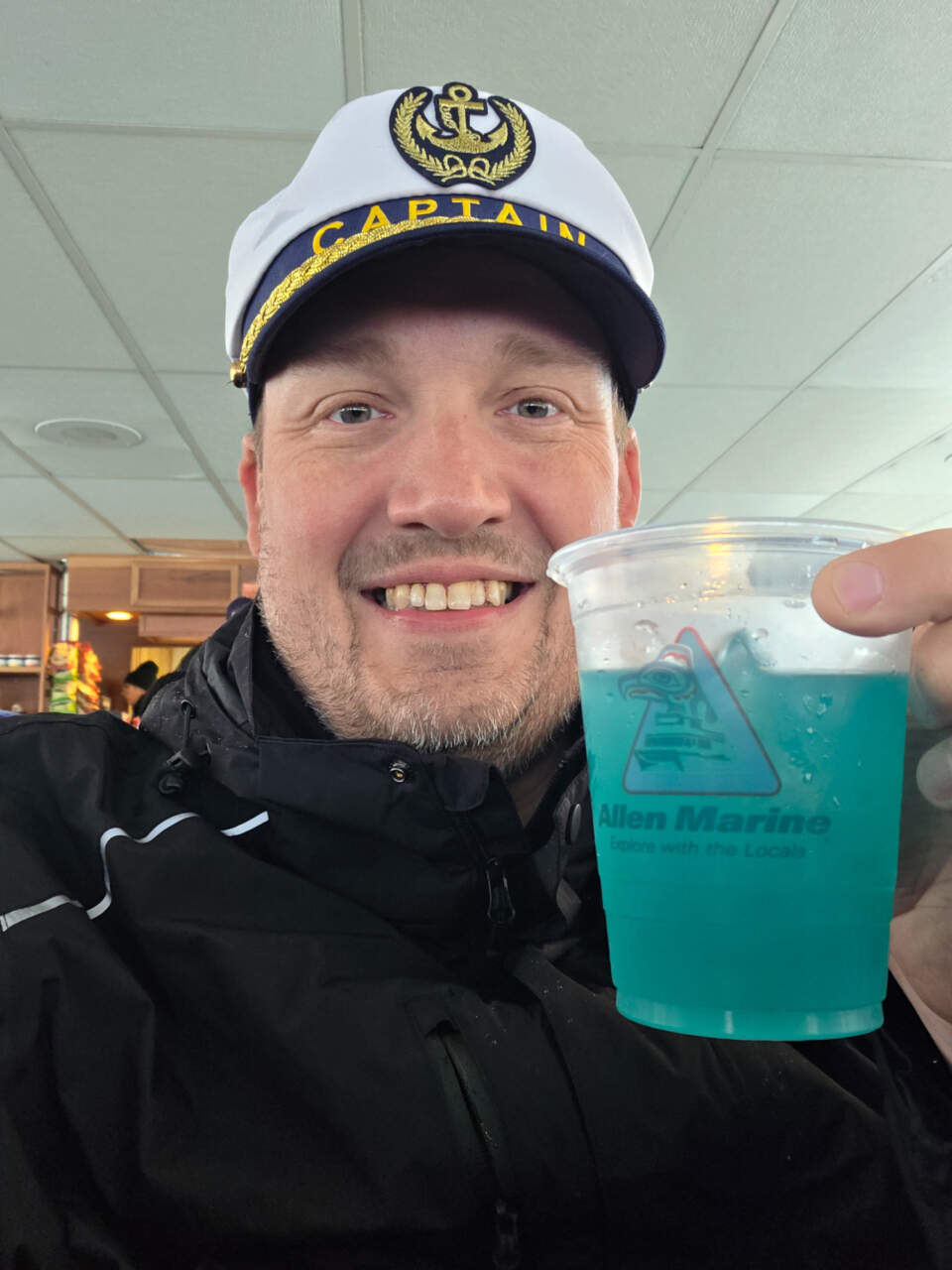
One hand on the rail, one on the “glacierita”—trying to hold onto the moment.
When Dawes Glacier finally revealed itself at the head of the fjord, it was like coming face to face with a sleeping giant. The ice wasn’t just white. It was blue—an impossible, glowing blue that made you wonder if someone had snuck neon lights behind it. The wall of it rose stories high, cracked and ridged like the skin of an ancient creature. The water around it was littered with ice, each shard reflecting the dull daylight in strange, glittering ways. The captain cut the engines and let us drift, the boat rocking gently as though it, too, was holding its breath. And then it happened. A sound first—like a gunshot wrapped in thunder.
And then it happened. A sound first—like a gunshot wrapped in thunder.
Heads turned just in time to see a piece of the glacier sheer off, slow at first, then accelerating with a violence that made my stomach drop. Tons of ice collapsed into the water, exploding into a foamy wave that surged outward, rocking our boat hard enough that everyone grabbed the railings. Some gasped. Some cheered. Me? I just stared, my phone still recording, but my brain barely processing that I was witnessing the Earth rearrange itself.
I’d read about glacier calving before, watched clips online, but being there in person felt different. It was primal. You don’t just see a glacier calve—you feel it. The sound crawls into your chest, rattling your ribs. The cold spray stings your face even at a distance. For a few seconds, it’s chaos, and then the silence after is somehow louder than before. It’s the kind of thing that makes you feel both insignificant and lucky at the same time.
Not everyone who visits Dawes gets to see calving. It’s like the glacier decides whether or not you’re worth the show. I caught it on video, sure, but I already knew no recording could capture the way it made the air vibrate. That was for me alone.
When the glacier quieted again, I realized my hands were trembling, not from the cold, but from adrenaline. That’s when one of the crew members handed me what they called a “glacierita.” A blue margarita, the exact same electric hue as the glacier itself, only this one came with a chunk of actual glacial ice floating in it like a prize. I held the glass up and swirled it, watching that ancient ice knock against the sides. Thousands of years frozen, and here I was about to drink from it.
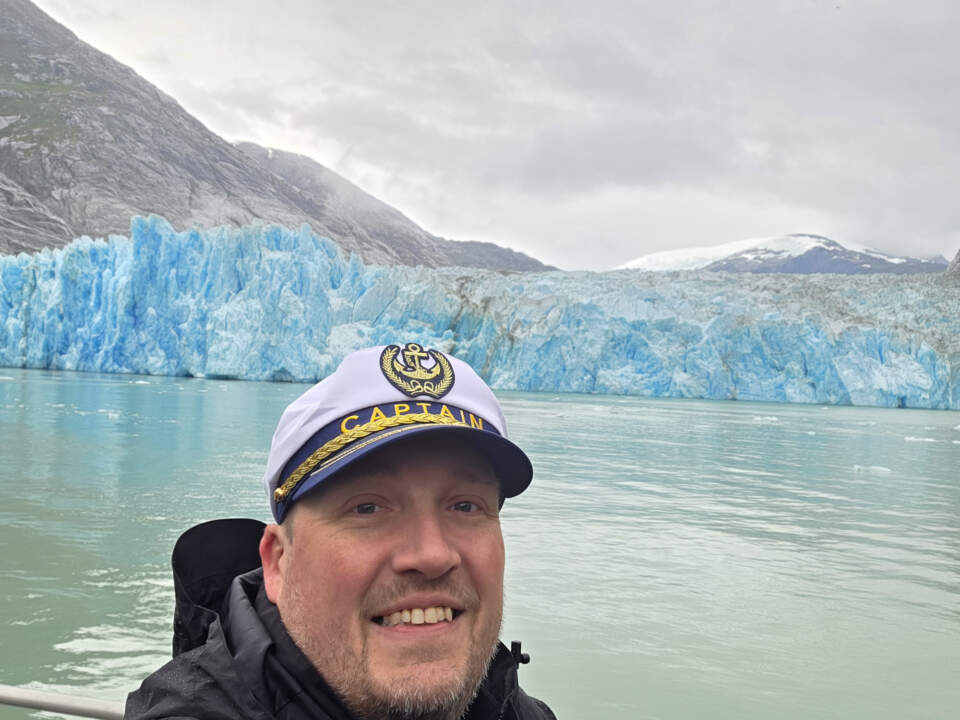
Calving-stunned and grinning—spray on my jacket, glacier at my shoulder.
I took a sip. The cold cut through me instantly, sharp and refreshing, but there was also this strange awareness of time, as if I was swallowing history in liquid form.
I took a sip. The cold cut through me instantly, sharp and refreshing, but there was also this strange awareness of time, as if I was swallowing history in liquid form.
I laughed at myself for being dramatic, but it was true. Nobody back home could say they’d toasted a glacier with its own ice.
The rest of the ride back felt different. We passed the same waterfalls, the same drifting icebergs, but now everything looked sharper, more alive. The clouds hung low and heavy, but the daylight didn’t fade—it just stretched endlessly, as if Alaska had no intention of turning off the lights anytime soon. The fjord smelled faintly of salt and moss, like the world before cities existed.
By the time we rejoined the cruise ship, my camera roll was full, but my mind kept circling back to that moment of calving. That crack, that thunder, that rush of water. It was more than scenery; it was proof that the Earth is never still, even if we are.
I’ve traveled before, but Alaska caught me off guard. I didn’t expect to be shaken by ice, of all things. And yet here I was, still buzzing, replaying the sound in my head. I thought about how few people had stood in that exact spot, on that exact day, with the glacier deciding to break apart right in front of them. I felt like the fjord had let me in on a secret.
When people ask what Alaska was like, I’ll tell them about Dawes Glacier. I’ll tell them I drank a margarita with a thousand-year-old ice cube. I’ll tell them I saw a mountain move. And I’ll know, deep down, that no words will ever quite measure up to that sound.
This story was the Grande Prize winner of the 2025 Alaska.org Story Contest.


